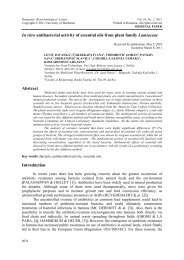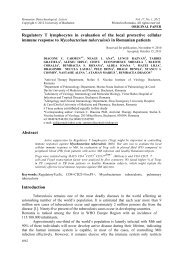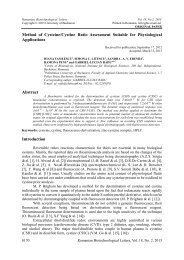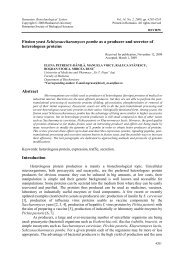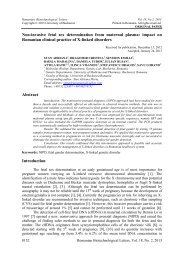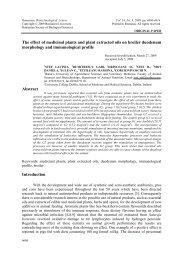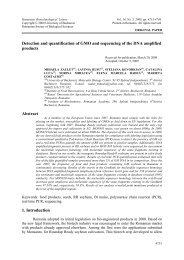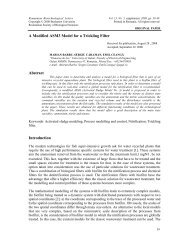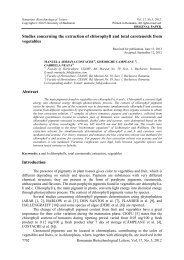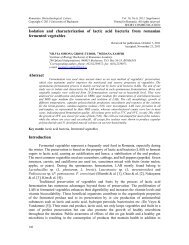RAPD analysis of genetic variation among some winter ... - Rombio.eu
RAPD analysis of genetic variation among some winter ... - Rombio.eu
RAPD analysis of genetic variation among some winter ... - Rombio.eu
You also want an ePaper? Increase the reach of your titles
YUMPU automatically turns print PDFs into web optimized ePapers that Google loves.
Romanian Biotechnological Letters Vol. 15, No.1, Supplement, 2010Copyright © 2010 University <strong>of</strong> BucharestPrinted in Romania. All rights reservedORIGINAL PAPER<strong>RAPD</strong> <strong>analysis</strong> <strong>of</strong> <strong>genetic</strong> <strong>variation</strong> <strong>among</strong> <strong>some</strong> <strong>winter</strong> barley cultivarsReceived for publication, October 19, 2009Accepted, January 15, 2010AbstractADRIANA CIULCA 1* , SORIN CIULCA 1 , EMILIAN MADOŞĂ 1 ,SORINA MIHACEA 1 , CERASELA PETOLESCU 11 Banat University <strong>of</strong> Agricultural Sciences and Veterinary Medicine, Faculty <strong>of</strong> Horticultureand Forestry, Calea Aradului, 119, 300645, Timisoara, Romania*the corresponding author: ciorogaadriana@gmail.comGenetic improvement <strong>of</strong> any crop species depends upon the existence, nature and extent <strong>of</strong> the<strong>genetic</strong> variability available for manipulation. Genetic <strong>analysis</strong> with <strong>RAPD</strong> markers has been extensivelyused to determine <strong>genetic</strong> diversity <strong>among</strong> barley varieties and to identify the best quality for malting,feeding, or human consumption. The objectives <strong>of</strong> the present study were to assess molecular <strong>variation</strong><strong>among</strong> different Romanian and foreign <strong>winter</strong> barley cultivars, and to determine the level <strong>of</strong> <strong>genetic</strong>similarity <strong>among</strong> them. The results demonstrated that <strong>RAPD</strong> analyses are useful for evaluation <strong>of</strong><strong>genetic</strong> diversity between different <strong>winter</strong> barley cultivars, considering the fact that the averagepolymorphic rate was 88.23 % and 10 polymorphic bands/primer. Based on the <strong>RAPD</strong> <strong>analysis</strong> usingthe three primers, we see that there is a high <strong>genetic</strong> variability between studied cultivars <strong>of</strong> <strong>winter</strong>barley, which can be exploited effectively in the improvement programs for this species. The use <strong>of</strong>cultivars from various clusters and sub clusters <strong>of</strong>fer the possibility <strong>of</strong> obtaining an appropriate<strong>genetic</strong> variability in hybrid populations. The band <strong>of</strong> 150 bp, amplified by the primer S39, which wasfound only in cultivars with high protein content, can be used for quick identification <strong>of</strong> high or lowprotein content cultivars.Keywords: <strong>winter</strong> barley, <strong>RAPD</strong>, <strong>genetic</strong> <strong>variation</strong>.IntroductionBarley (Hord<strong>eu</strong>m vulgare L) is a potentially useful grain for different purposes. It iswidely used for brewing and for animal feed. Due to its high soluble fiber content andnutritional significance, barley has become a desirable grain for human consumption,especially hull-less varieties with high β-glucan content (Bathy, [1]; Gill et al., [2]).Otherwise, varieties with low β-glucan content are foraged for their low viscosity (Yu et al.,[3]).Genetic improvement <strong>of</strong> any crop species depends upon the existence, nature and extent<strong>of</strong> the <strong>genetic</strong> variability available for manipulation (Waugh et Powell, [4]). Genetic <strong>analysis</strong> with<strong>RAPD</strong> markers has been extensively used to determine <strong>genetic</strong> diversity <strong>among</strong> barley varietiesand to identify the best quality for malting, feeding, or human consumption (Todorovska et al.,[5]; Diaz-Perales et al., [6]; Fernandez et al., [7]; Hang et al., [8]; Selbach & Cavalli-Molina, [9];Baum et al., [10]).<strong>RAPD</strong> technique is based on the fact that copies <strong>of</strong> a single arbitrary primer with aspecific sequence <strong>of</strong> bases, binds to its complementary sequences that can be found scatteredat random in the studied genome. Studies conducted on different primers with arbitrarysequence have established that to produce detectable levels <strong>of</strong> amplification, the minimum19
<strong>RAPD</strong> <strong>analysis</strong> <strong>of</strong> <strong>genetic</strong> <strong>variation</strong> <strong>among</strong> <strong>some</strong> <strong>winter</strong> barley cultivarslength <strong>of</strong> primers should be nine bases, while in case <strong>of</strong> decamer primers guanine andcytosine should be at least 40% (Williams et. al., [11]).Each primer, generally determines the amplification <strong>of</strong> sequences from several genome loci,this being the reason why this technique is an effective means <strong>of</strong> assessing DNApolymorphism in different genotypes (Molnar et. al., [12]).The objectives <strong>of</strong> the present study were to assess molecular <strong>variation</strong> <strong>among</strong> differentRomanian and foreign <strong>winter</strong> barley cultivars, and to determine the level <strong>of</strong> <strong>genetic</strong> similarity<strong>among</strong> them.Materials and methodsPlant material: Ten leaves from each <strong>of</strong> the 30 cultivars were collected separately andstored immediately at –80 0 C for DNA extraction.DNA extraction: DNA was extracted from stored leaves usingcetyltrimethylammonium bromide (CTAB) method.<strong>RAPD</strong> <strong>analysis</strong>: In order to analyze the <strong>genetic</strong> polymorphism <strong>of</strong> <strong>winter</strong> barleycultivars three dominant <strong>RAPD</strong> primers were used, S18, S32 and S39, respectively.PCR was carried out essentially as described by Williams et al., [11]. The PCRreaction mixture (25 μL) contained approximately 50 ng <strong>of</strong> barley DNA, 0.5 μM <strong>of</strong> primer,0.2 mM <strong>of</strong> each dNTP, 10 mM Tris-HCl (pH 8.0), 50 mM KCl, 2 mM MgCl2 and 1U <strong>of</strong> TaqDNA polymerase.PCR reactions were performed in thermal cycler (Corbett) programmed for 94°C for 5min., 45 cycles <strong>of</strong> 94°C for 30 sec., 35°C for 45 sec., 40°C for 45 sec., 45°C for 45 sec., 72°C for1.5 min., and finally 72°C for 10min. Amplification products were separated by electrophoresis(3V cm -1 ) in 1.5 % agarose gel and detected using ethidium bromide und UV light.Cluster <strong>analysis</strong>: Each amplifications was performed using a single primer gels scoredfor the presence (1) and absence (0) <strong>of</strong> products. Each amplified band was named accordingto size and primer used.These data were used for calculation <strong>of</strong> pairwise <strong>genetic</strong> distances <strong>among</strong> cultivars usingthe Jaccard coefficient with <strong>RAPD</strong> Distance Program, version 1.04. Jaccard similaritycoefficient was used because it does not consider absence <strong>of</strong> bands as a similarity. The degree<strong>of</strong> <strong>genetic</strong> similarity between each pair <strong>of</strong> the 30 cultivars were calculated using the simpleequation: JC =a/(a+b+c), where „a” is the number <strong>of</strong> bands shared by plant „m” and plant „m”,„b” is the number <strong>of</strong> bands in plant „m”, and „c” is a number <strong>of</strong> bands in plant „n”. The distancematrix was used for cluster <strong>analysis</strong> using the unweighted pair-group method with arithmeticaverages (UPGMA), with the Neighbor program <strong>of</strong> the Phylip package, version 3.5c.Results and DiscussionsAll three used <strong>RAPD</strong> primers generated polymorphic bands, resulting a polymorphicrate with values between 70% in case <strong>of</strong> S18 and 100% for primer S32. In the study only clearbands <strong>of</strong> DNA was considered, 10 for S18 and S39 primers, and 14 bands for S32 primer(table 1).Table 1. Polymorphism rate for the <strong>winter</strong> barley cultivars using S18, S39 and S32 primersNo. Primer Sequence Bands number Polimorphyc Bands sizecode (5’-3’) Total Polimorphyc rate (pb)1 S18 CCACAGCAGT 10 7 70 180-15502 S32 TCGGCGATAG 14 14 100 400-15003 S39 CAAACGTCGG 10 9 90 150-115020Romanian Biotechnological Letters, Vol. 15, No. 1, Supplement (2010)
ADRIANA CIULCA, SORIN CIULCA, EMILIAN MADOŞĂ,SORINA MIHACEA, CERASELA PETOLESCUAmplified fragments had sizes between 180 and 1550 bp for primer S18, and 150-1150 bp for S39 primer respectively, while primer S32 presented lower amplitude <strong>of</strong> theamplified fragment size (400 and 1500 bp). Minimum difference size between any twopolymorphic bands generated by one primer were 100 bp for S18, 50 bp for S39 and 20 bp inthe case <strong>of</strong> S32 primer. Considering all three <strong>RAPD</strong> primers included in the study, resulted anaverage number <strong>of</strong> 10 polymorphic bands/primer. Thus, <strong>of</strong> the 34 bands generated by <strong>RAPD</strong>primers included in the study, 30 were polymorphic, resulting an 88.23% average <strong>of</strong>polymorphism.DanaAndreiTasMadalinRegalSalemerOrizontDinaPlaisantNellyCenterMajestikLyricGerbelTurulLandiReziSecuraMalwintaKunsagiViktorMetalJudyAdiParisPrecoceCompactGoticLawerdaPuszta1.00.90.80.70.6 0.5 0.4Similarity coefficientFig. 1. UPGMA clustering <strong>of</strong> <strong>winter</strong> barley cultivars using the <strong>RAPD</strong> primersAccording to the dendrogram <strong>of</strong> fig. 1. it can be seen that the Romanian cultivarsDana and Andrei present a <strong>genetic</strong> similarity <strong>of</strong> about 76 % and constitute a first subgroup <strong>of</strong>the first cluster, together with Tas cultivar. The second subgroup is composed <strong>of</strong> Madalin,Regal and Salemer cultivars showing an average <strong>genetic</strong> diversity <strong>of</strong> approximately 32 %.A second cluster consists <strong>of</strong> cultivars: Orizont, Dina, Plaisant, Nelly, Center, Majestik,Lyric, Gerbel, recording a <strong>genetic</strong> similarity <strong>of</strong> 64 % between them, and an average diversity<strong>of</strong> approximately 62 % toward the first cluster.The third cluster included the cultivars Turul, Landi, Rezi, Secura, Malwinta whichhas a frequency <strong>of</strong> about 65% <strong>of</strong> common alleles.The group <strong>of</strong> Hungarian cultivars Kunsagi, Viktor, Metal, Judy showed an average<strong>genetic</strong> diversity <strong>of</strong> 42 %. The last cluster composed <strong>of</strong> seven cultivars showed an average<strong>genetic</strong> similarity <strong>of</strong> 57 % between them.Romanian Biotechnological Letters, Vol. 15, No. 1, Supplement (2010) 21
<strong>RAPD</strong> <strong>analysis</strong> <strong>of</strong> <strong>genetic</strong> <strong>variation</strong> <strong>among</strong> <strong>some</strong> <strong>winter</strong> barley cultivarsAs such, the use <strong>of</strong> cultivars from various clusters and sub clusters listed above <strong>of</strong>fersthe possibility <strong>of</strong> obtaining an appropriate <strong>genetic</strong> variability in hybrid populations.Regarding the <strong>analysis</strong> <strong>of</strong> variance for <strong>winter</strong> barley cultivars studied in terms <strong>of</strong>bands amplified by <strong>RAPD</strong> primers (table 2), high significant values <strong>of</strong> variance were recordedfor the cultivars: Dina, Plaisant, Majestik, Secura, Salemer, Regal, Orizont, Landi. A lowvariability <strong>of</strong> the band distribution was observed in cultivars: Puszta, Precoce, Judy, Gotic,Adi, Lawerda.Table 2. Analysis <strong>of</strong> variance for the <strong>winter</strong> barley cultivars concerning the different bands <strong>of</strong> the <strong>RAPD</strong> primersNo. Cultivar Between gropus Within gropus F testSS DF SS DF1 DANA 1.606 1 5.361 28 8.39**2 ADI 0.089 1 7.278 28 0.343 MADALIN 0.356 1 7.111 28 1.404 ORIZONT 2.006 1 5.361 28 10.47**5 PRECOCE 0.022 1 6.944 28 0.096 ANDREI 0.556 1 6.111 28 2.557 COMPACT 0.272 1 6.028 28 1.268 REGAL 2.006 1 5.194 28 10.81**9 PLAISANT 4.050 1 3.417 28 33.19**10 KUNSAGI 0.272 1 7.194 28 1.0611 PUSZTA 0.022 1 7.444 28 0.0812 VIKTOR 0.939 1 6.528 28 4.0313 METAL 0.089 1 5.278 28 0.4714 NELLY 1.250 1 6.250 28 5.60*15 CENTER 0.939 1 6.528 28 4.0316 TURUL 0.556 1 6.944 28 2.2417 GOTIC 0.089 1 7.278 28 0.3418 PARIS 0.356 1 7.111 28 1.4019 JUDY 0.050 1 4.750 28 0.2920 REZI 0.356 1 6.611 28 1.5121 TAS 0.939 1 6.528 28 4.0322 SALEMER 2.450 1 4.917 28 13.95**23 LANDI 2.006 1 5.361 28 10.47**24 DINA 4.356 1 2.611 28 46.71**25 MAJESTIK 3.472 1 4.028 28 24.14**26 LAWERDA 0.139 1 6.528 28 0.6027 LYRIC 1.800 1 5.667 28 8.89**28 GERBEL 1.250 1 5.417 28 6.46*29 SECURA 3.200 1 4.000 28 22.40**30 MALWINTA 0.450 1 6.750 28 1.87The highest frequency <strong>of</strong> polymorphic bands was observed in cultivars: Puszta, Adi,Gotic, Kunsagi, Madalin, Paris. At the same time the varieties: Dina, Plaisant, Secura,Majestik, had the lowest frequency <strong>of</strong> polymorphic bands for <strong>RAPD</strong> primers.22Romanian Biotechnological Letters, Vol. 15, No. 1, Supplement (2010)
ADRIANA CIULCA, SORIN CIULCA, EMILIAN MADOŞĂ,SORINA MIHACEA, CERASELA PETOLESCUTable 3. Analysis <strong>of</strong> variance for the polymorphic bands <strong>of</strong> the <strong>RAPD</strong> primers in the <strong>winter</strong> barley cultivarsNo. Bands Between Within groups F testgropusSS DF SS DF1 S 18- 180 0.041 1 3.426 28 0.332 S 18- 420 0.500 1 6.967 28 2.013 S 18- 750 0.781 1 5.885 28 3.724 S 18- 930 0.013 1 6.287 28 0.065 S 18- 1050 0.674 1 3.493 28 5.40*6 S 18- 1150 0.153 1 6.813 28 0.637 S 18- 1550 0.016 1 6.651 28 0.078 S 39- 150 0.153 1 6.813 28 0.639 S 39- 220 2.695 1 3.971 28 19.00**10 S 39- 290 3.171 1 3.129 28 28.37**11 S 39- 340 0.070 1 6.230 28 0.3212 S 39- 550 0.695 1 4.105 28 4.74*13 S 39- 650 0.695 1 4.105 28 4.74*14 S 39- 850 0.163 1 5.703 28 0.8015 S 39- 930 1.099 1 6.268 28 4.91*16 S 39- 1150 2.572 1 4.794 28 15.02**17 S 32- 400 0.134 1 6.833 28 0.5518 S 32- 500 0.716 1 6.651 28 3.0119 S 32- 580 0.613 1 5.254 28 3.2720 S 32- 700 0.174 1 2.526 28 1.9321 S 32- 750 0.500 1 6.967 28 2.0122 S 32- 810 0.003 1 7.464 28 0.0123 S 32- 840 0.653 1 6.813 28 2.6824 S 32- 870 0.084 1 7.282 28 0.3225 S 32- 890 0.064 1 6.603 28 0.2726 S 32- 910 0.613 1 5.254 28 3.2727 S 32- 950 0.243 1 6.057 28 1.1228 S 32- 1050 0.084 1 7.282 28 0.3229 S 32- 1250 1.563 1 4.737 28 9.24**30 S 32- 1500 0.295 1 5.072 28 1.63According to the <strong>analysis</strong> <strong>of</strong> variance for the polymorphic bands <strong>of</strong> the <strong>RAPD</strong> primers,results that the highest significant variability is recorded separately for bands: S39- 290;S39- 220; S39- 1150; S32- 1250; S18- 1050, which determine a significant differentiation <strong>of</strong>studied cultivars. Also, the bands: S32- 810; S18- 1550; S18- 180; S18- 930; had the highesthomogeneity.The band <strong>of</strong> 150 bp, amplified by the primer S39, appeared generally in case <strong>of</strong>varieties with high grain protein content, not being present in the varieties with a low content.As such, in view with the results <strong>of</strong> other researchers (Yu et al., [13]), that fragment can b<strong>eu</strong>sed in breeding programs to identify genotypes with low beta-glucan or high protein content,having in view the correlations between the two grain components.Romanian Biotechnological Letters, Vol. 15, No. 1, Supplement (2010) 23
<strong>RAPD</strong> <strong>analysis</strong> <strong>of</strong> <strong>genetic</strong> <strong>variation</strong> <strong>among</strong> <strong>some</strong> <strong>winter</strong> barley cultivarsConclusionsThe results demonstrated that <strong>RAPD</strong> analyses are useful for evaluation <strong>of</strong> <strong>genetic</strong>diversity between different <strong>winter</strong> barley cultivars, considering the fact that the averagepolymorphic rate was 88.23 % and 10 polymorphic bands/primer.Based on the <strong>RAPD</strong> <strong>analysis</strong> using the three primers, it was found out that there is ahigh <strong>genetic</strong> variability between the studied cultivars <strong>of</strong> <strong>winter</strong> barley, which can be exploitedeffectively in the improvement programs for this species. The use <strong>of</strong> cultivars from variousclusters and sub clusters <strong>of</strong>fers the possibility <strong>of</strong> obtaining an appropriate <strong>genetic</strong> variabilityin hybrid populations.The band <strong>of</strong> 150 bp, amplified by the primer S39, which was found only in cultivarswith high protein content, can be used for quick identification <strong>of</strong> high or low protein contentcultivarsReferences1. BHATTY, R.S. The potential <strong>of</strong> hull-less barley. Cereal Chemistry, v.76, p.589-599, 1999.2. GILL, S., VASANTHAN, T., OORAIKUL, B., ROSSNAGEL, B. Wheat Bread Quality as Influencedby the Substitution <strong>of</strong> Waxy and Regular Barley Flours in Their Native and Extruded Forms. Journal <strong>of</strong>Cereal Science, v.36, p.219-237, 2002.3. YU, P., MEIER, J.A., CHISTENSEN, D.A., ROSSNAGEL, B.G., McKINNON, J.J. Using the NRC-2001 model and the DVE/OEB system to evaluate nutritive values <strong>of</strong> Harrington (malting-type) andValier (feedtype) barley for ruminants. Animal Feed Science and Technology, v.107, p.45-60, 2003.4. WAUGH, R., POVELL, W. Using <strong>RAPD</strong> markers for crop improvement. Tibtech, 10: 186-191, 1992.5. TODOROVSKA, E., TRIFONOVA, A., ATANASSOV, A. Genetic diversity <strong>among</strong> elite Bulgarianbarley varieties evaluated by RFLP and <strong>RAPD</strong> markers. Euphytica, v.129, p.325-336, 2003.6. DIAZ-PERALES, A., LINACERO, R., VÁZQUEZ, A.M. Analysis <strong>of</strong> <strong>genetic</strong> relationships <strong>among</strong> 22European barley varieties base on two PCR markers. Euphytica, v.129, p.53-60, 2002.7. FERNANDEZ, M.E., FIGUEIRAS, A.M., BENITO, C. The use <strong>of</strong> ISSR and <strong>RAPD</strong> markers fordetecting DNA polymorphism, genotype identification and <strong>genetic</strong> diversity <strong>among</strong> barley cultivarswith known origin. Theoretical and Applied Genetics, v.104, p.845-851, 2002.8. HANG, A., BURTON, C.S., HOFFMAN, D.L., JONES, B.L. Random amplified polymorphic primergeneratedembryo DNA polymorphisms <strong>among</strong> 16 North American malting barley cultivars. Journal <strong>of</strong>the American Society <strong>of</strong> Brewing Chemists, v.58, p.147-151, 2000.9. SELBACH, A., CAVALLI-MOLINA, S. <strong>RAPD</strong> characterization <strong>of</strong> Brazilian barley (Hord<strong>eu</strong>m vulgaressp vulgare) varieties. Euphytica, v.111, p.127-135, 2000.10. BAUM, B.R., MECHANDA, S., SOLEIMANI, V. Identification <strong>of</strong> Canadian six row barley (Hord<strong>eu</strong>mvulgare L) cultivars with primers derived from STSs obtained from <strong>RAPD</strong> diagnostic bands. SeedScience and Technology, v.28, p.445-466, 2000.11. WILLIAMS, J.G.K, KUBELIK, A.R., LIVAK, K.J., RAFALSKI, J.A., TINGEY, S.V. DNApolimorfisms amplified by arbitrary primers are useful as <strong>genetic</strong> markers. Nucleic Acids Res. 18, 6531-6535, 1990.12. MOLNAR, SJ, JAMES, LE, and KASHA, KJ Inheritance and <strong>RAPD</strong> tagging <strong>of</strong> multiple genes forresistance to net blotch in barley. Genome, 2: 224-231, 2000.13. YU, Z., LI-QIONG, L., HUAN, L., JIE, B., MAN-YE, Y., CHEN, M., YING-FAN, C., XIAO-LIN, Q.,FANG, C. <strong>RAPD</strong> markers in diversity detection and variety identification <strong>of</strong> Tibetan hulless barley,Plant Molecular Biology, 20: 369-377, 2002;24Romanian Biotechnological Letters, Vol. 15, No. 1, Supplement (2010)



